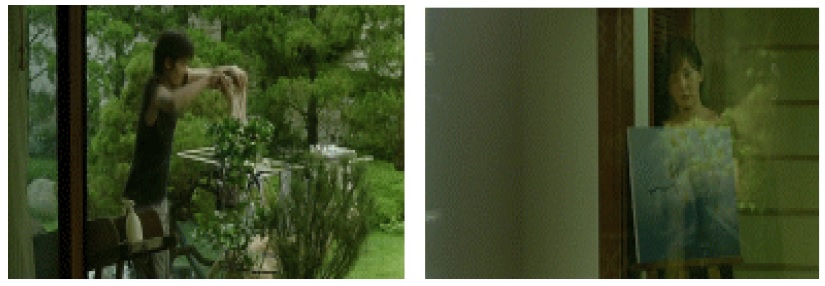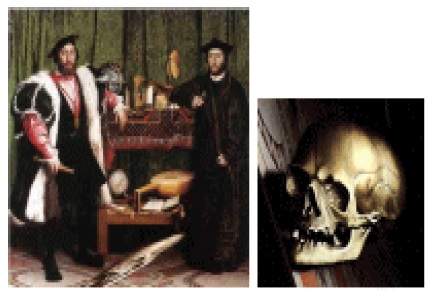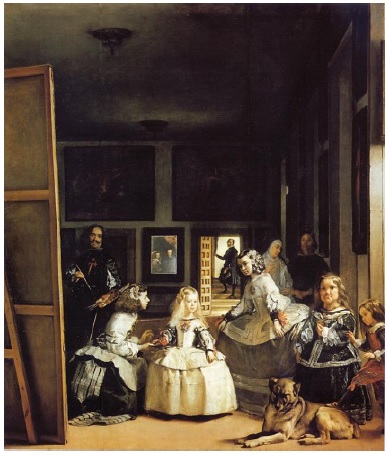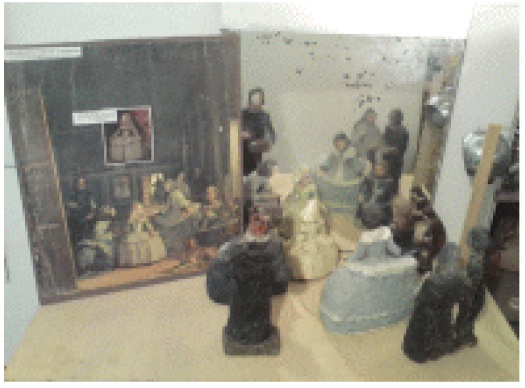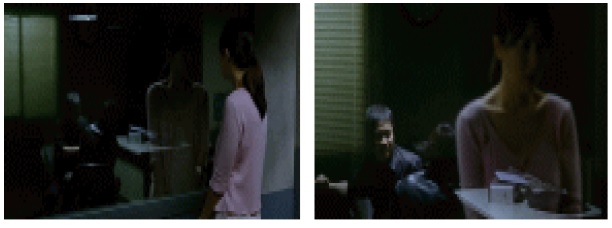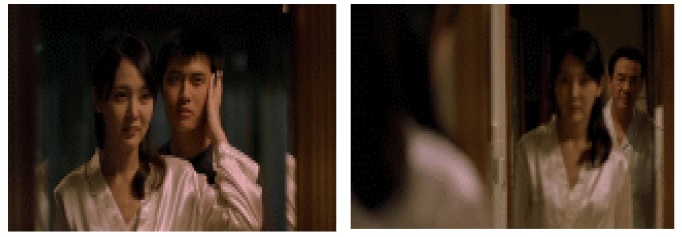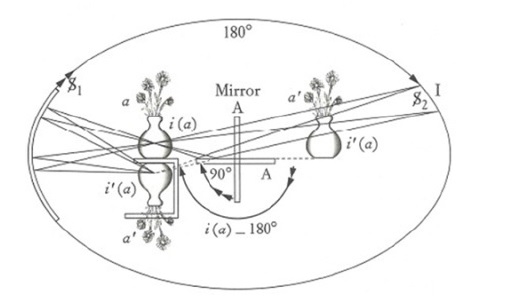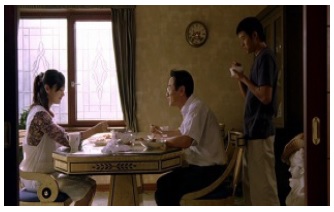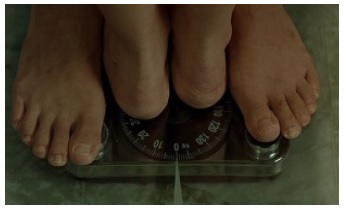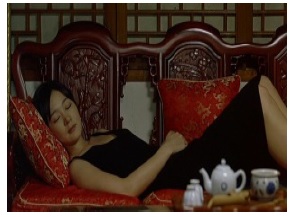


Kim Ki-duk’s
Then how does this film unveil the truth? I would claim that
Following this will be an exploration of the protagonists’ enigmatic activities, with a particular emphasis on their different ways of enjoying freedom. In fact, Kim’s previous films tended to conclude in fantastical situations wherein the protagonists would either destroy themselves or enter into a harmonized co-existence with their opponents through some dramatic exchange, or depreciation, of their respective social positions. These endings were akin to closing the curtains just as the Moebius strip began to reverse upon itself. In contrast,
This next stage begins when T’aesŏk and Sŏnwha are caught by the police by accident. Here, we should pay attention to a big difference between the choices T’aesŏk and Sŏnwha make shortly afterwards: T’aesŏk decides to erase his physicality from the Symbolic (or the social reality, in sociological terms) while Sŏnwha goes back home and ends up living together with her husband and her phantom-lover. Again, via Lacan’s theory of sexuation, which explains why radical resistance and systemic change should be exerted by feminine subjectivity, I would like to interpret the female protagonist’s freedom not as a mere deviation in order to maintain her trans-gressive love but a metaphor of feminine subjectivity which makes it possible for her to refuse reality without leaving it and to alter its dominant signifying system from inside. From this point of view, Kim’s entire oeuvre can be exonerated from the earlier disparaging criticisms made against it, including feminist ones,1 and be appreciated in a more balanced way. Furthermore, a feminine-focalized reading of this film can demonstrate
1Chŏng Hae-sŭng provides a good recapitulation of diverse opinions on Kim’s films in both Korean and western academia (H-S Jŏng 2012: 16–22).
2. IN-BETWEEN TWO MIRRORS: VISUAL SPECTRALITY REFLECTED ON AN INTERFACE-SCREEN
T’aesŏk, presumably in his late twenties, is a totally unknowable man until a policaman provides the minimal information that he is a college graduate. He drives a seemingly-expensive BMW motorcycle, and dares to break into a temporarily vacated house when the takeaway restaurant flier he has hung on the door as a test is not removed. Once inside, he makes himself at home cleaning the house, washing the dirty clothes and sneakers, spraying the plants, and fixing the appliances. He moves onto other homes, repeating the same pattern. On one of these occasions, in an upper-class residence, an unexpected incident occurs: even though T’aesŏk thought no one was there, Sŏnwha, whose face has been bruised by her husband Min’gyu, is inside. Considering that the Korean title of this film is ‘empty house’ (
Then, who is indeed living in this house? Is it the seemingly autistic resident Sŏnwha, or the active intruder T’aesŏk? Insofar as they don’t belong to the house properly, their presence is ghost-like in a way. The elaboration of this ghostliness or spectrality can be claimed to be the most outstanding achievement of
According to Bliss Cua Lim, who explores “spectral time” relying on Henri Bergson’s philosophy, “the temporality of haunting … refuses the linear progression of modern time consciousness” and is linked to “an undoing of homogeneous space” (Lim 2009: 149). In
Similarly, one can observe interesting mise-en-scènes when Min’gyu grills Sŏnwha after coming back from his business trip and T’aesŏk happens to see them [Figure 2]. The married couple inside and T’aesŏk outside are demarcated by the window, but then all three of them appear reflected on the same window. Finally, Mingyu looks at T’aesŏk through the window on which Sŏnwha is vaguely reflected beside him. The first shot distinguishes the residents from the intruder, yet the second and third shots proclaim that the real outsider among them will be Min’gyu eventually. This recoupling is indicated by the relationships they form with the spectrality mediated by the window: Sŏnwha and T’aesŏk are blurry, while Min’gyu is clear. It is extremely difficult to see the dark outside scene, allocated to the incorporeal and de-physicalized, from the lit inside of the house allocated to the corporeal/physical. Their relationship is basically antinomic, so they cannot share anything. In that sense,
The use of the window frame as a medium of reconfigurating or splitting the diegetic homogeneous spaces reminds us of Zizek’s concept of “interface-screen” (see Zizek 2001: chap. 2) derived from Lacan’s concept of “the screen” on which the binary opposites in Lacan’s image theory hinge.2 Since Lacan would only describe this concept in reference to a few paintings, Zizek contrives the term ‘interface-screen’ to apply it to cinematic images.3 Since these images are not mere snapshots—contrary to Lacan’s emphasis on “the effect of arresting movement and, literally, of killing life” (Lacan 1977: 118)—, Zizek needed to take the problem of editing into account by reinterpreting the suture theory formulated in the 1970s.4 In reference to the suturing process, however, Zizek focuses on the failure of proper suturing when the point-of-view shot (shot 2) is not clearly signified or subjectificated by the objective shot (shot 1), and thus “will evoke the spectre of a free-floating Gaze without a determinate subject to whom it belongs” (Zizek 2001: 33). Operating as “the direct stand-in for the absent one” (ibid.: 52), the function of the interface-screen is to undermine the standard procedure of suture and introduce the spectral dimension of gaze into reality in a single shot with the shot and reverse shot condensed together. Consequently, this stand-in not only destroys the stability of the world to which the characters belong, but also annihilates the ideological and fantasmatic effect operating within that world because it arouses the idea that “our universe is not in itself fully ontologically constituted” (ibid.: 53) and makes us aware that “an interface-artificial moment” as a fantasmatic supplement is essential to “suture-stitch” for an appearance of consistency in the universe (ibid.: 54). How does this take place?
With regard to the interface-screen effect, Zizek mentioned the exemplary shots from
Yet, there is an apparent difference between the window-screen in
However, as screens to capture the division of the subjects, the big window in the film and the big mirror in the painting function differently. The transparent window makes the split subjectivity appear as being literally divided between the physical and the spectral, as mentioned above. In comparison, according to Lacan’s analysis, the opaque surface of the painting contains the division as a set of paired antinomic relationships in a frame:
Then, how can the different topological status of the various personages, especially the royal couple, little Infanta, and artist, be applied to the characters in the film? If
First, the presence of the royal couple plays the same role as the God of Descartes which corresponds to the function of the Other, therefore being supposedly omnipresent, omnivoyant and omniscientific. However, the couple’s presence is possible thanks to the intervention of the artist who dares to ignore the realistic representation and paints the illusionary couple in the mirror as if they are reflected. Lacan also denigrates the God as “a pure articulation of a mirage” (ibid.: May 25) with “the empty eye which, like all eyes, is made to see nothing” (ibid.: June 1). In fact, the royal couple in the position of seeing the backs of the other personages cannot see anything, insofar as the latter exist only as paintings without any substantial backs and even the reversed canvas, on which the couple is likely to cast a look, offers nothing to be seen with its right side out. The visual incompetence of the king and queen indicates the fundamental incompleteness of the Other. Dylan Evans summarizes that “the symbolic phallus is that which appears in the place of the lack of the signifier in the Other” (Evans 1996: 143). The lack of the signifier of “the royal couple = the Other”, that is, their blindness or the frustration of the desire to see, is incarnated by “the princess = phallus” (Lacan 65-66: May 25). Intriguingly enough, Lacan notes that the beautiful central personage has her hidden legs encompassed by the dress, or “the slit” (Lacan 65-66: May 25) as the signifier of the castrated phallus.
Meanwhile, the princess is about to cry, exclaiming, “let me see” what is on the canvas that Velasquez is painting. In reply, the artist says: “You do not see me from where I am looking at you” (ibid.: May 18). Why not? Firstly, because she wants to see it as a representation in perspective, yet the canvas has nothing to do with this but instead with the representative of representation; and, secondly, because the little Infanta is still the subject of the look believing in her mastery of the whole scene with her eyes, while Velasquez is the subject of the gaze, a “phantasmagoria personage” (ibid.: May 25) “in a state of absence” (ibid.: May 18), using his gaze as a trap for captivating the spectators. In addition, the fact that Velasquez placed himself in the middle among many slits or gaps between the personages, and that his portrait seems to be escaping towards the outside, posed as if in parallel to the gap in front, support his specific relation to the topological level of the Real. Hence, Velasquez is defined paradoxically as a “bad painter” who produces “a bad painting”, “a bad conception of the world”, and who “sees in the world the macrocosm of the microcosm that we are supposed to be” (ibid.: 25 May). In that regard, the portrait of the artist shares the topological status connected to the Real with another “
From the above analysis, one could read the parallel relationship between
Yet, there still remains a problematic hurdle to jump because unlike the painting, the film does not stop with the immobility of
2To summarize, Lacan claims that the vision of the subject is divided between the “look” as the eye “that is satisfied with itself in imagining itself as consciousness” (Lacan 1977: 74) and the “gaze” as the unapprehensible “underside of consciousness” (ibid.: 83). The look is related to the vanishing point of perspective based on classical geometry, the gaze to the infinite point in projective geometry. That is why Lacan spoke of “the representative of representation” (Vorstellungsrepäsentanz in Freud’s terms), which takes the place of representation. This is the demonstrable appearance of the Real: the unsignifiable and irrepresentable void; the nothing or zero around which the Symbolic as fictitious fantasy of the subject is constructed. Therefore, the “screen” as “the locus of mediation” (Lacan 1977: 107) of the gaze has nothing to do with the physical canvas or screen, but refers to the virtual level of space where the representative of representation takes place. 3For closer research on Zizek’s broader application of Lacan’s theory of painting to the theory of film, a spatiotemporal medium, see Kim (2013). 4The kernel of classical suture theory is that the presumed “absent one” as the gap between shot 1 and shot 2 is obliterated or suppressed in the exchange of looks, allocating the place of the threatening Absent Cause to the viewing character within the space of diegetic fiction in shot 1; and this suppression, or suturing, engenders the ideological effect of the structure as a self-contained totality of signifying representation. In order to track down the history of discussion about the suture theory, the following list would be helpful. Miller (1977-78) ; Oudart (1977–78); Dayan (1976); Salt (1977); Salt (1978); Rothman (1976); Heath (1981); Bordwell (1985); Carroll (1988); Allen (1995); Zizek (2001). 5One cannot differentiate 1 and 1+0, but still there is a logical difference between them. That is the minimal difference created by the addition of 0, the level of the Real. One of the famous examples of minimal difference is ‘the shadow at noon’. Common sense tells us there is no shadow at noon, but there is the logical existence of shadows at noon, which makes the minimal difference from no shadows. 6About Lacan’s analysis of Las Meninas, see Lacan (1965–66), May 4, 1966; May11, 1966; May 18, 1966; May 25, 1966. Further references to Seminar XIII will be to the date of the oral transmission since the English translation has no page numbers. 7Foucault considered the king and queen to be confronting the entire scene being painted on the reverted canvas in front of the artist, and therefore reflected at the back in the mirror. 8Oudart depended upon Foucault in order to argue about the characteristic of bourgeois representation by showing how the imaginary figures of the king and queen taking the place of the real painter, who is playing the fantasy role of king, lure the spectator, excluded from the visual field that has been turned into a spectacle, without knowing anything of the reality effect. 9When Lacan asks Foucault if he is ‘deforming’ Foucault’s comprehension of Las Meninas, Foucault answers that Lacan is ‘reforming’ it. 10The reason for Lacan’s objection is that, first of all, he estimates that the royal couple in the mirror should be reduced in scale to be twice as small as Nieto Velasquez, who is next to them, considering the distance between the mirror and where the couple is supposed to be (May 11). Concerning another hypothesis that there is a huge mirror in front of the whole scene, and that the artist is trying to draw the people as they appear in that mirror [Figure 6], yet again, Lacan finds it to be contradictory because there is no historical record to prove that Velasquez was left-handed in reality and at least two figures from the trio of a supposedly large mirror, the king and queen, and the painter cannot be placed at the same location. 11Lacan also applies the notion of montage to the structure of the fantasy (“something like a montage … is essential for what we are aiming at having the experience of, namely, the structure of the fantasy” [Lacan 1965–66: May 4]) and to the drive (which is “not an instinct, but a montage, a montage between realities of an essentially heterogeneous level” [ibid.: May 18].
3. OUT OF MIRRORS: DIVISION IN PERSPECTIVE SYSTEM AND TACTILE VISUALITY AS ALTERNATIVE
Let us rewind to a point when T’aesŏk has not yet encountered Sŏnwha. The film shows T’aesŏk sneaking into an empty flat, whose family has left for a trip. Applying Lacan’s antinomic concepts of the Symbolic and the Real once again, the fact that T’aesŏk can occupy an empty house only, in other words, that he should take the risk of being beaten and thrown out of the house, once the original family returns, indicates that he involves in the Real, which must be suppressed and foreclosed in the Symbolic. However, he enjoys living there in exactly the same way as the original residents do: wearing their clothes, eating their food and using their bed, as the vanishing point and infinite point are distinguished only in their minimal difference. Surely, the house will never be the same following the intrusion of the Real, resulting in fatal changes as the mother is wounded by her boy playing with the toy gun that T’aesŏk repaired.
Interestingly, in most houses where T’aesŏk takes up residence, there is a big photo of the family members in the living room. This photo has been taken in an artificially happy atmosphere which conceals the family’s troubling issues, meta-phorically exposed by the broken things and unwashed clothes remaining in the house. When staying in such places, T’aesŏk always takes photos of himself against the background of the family photo. What a spirit of recording! According to Lacan, the system of perspective is premised on the transparent and omnivoyant subject which is, however, merely imaginary because the world in perspective is always already dislocated from itself by its minimal difference or otherness. In that sense, T’aesŏk’s recordings are interpreted not just as a simple collection of his temporary residences, but effective moments of subverting the topological status of the subject. A new family photo with T’aesŏk framed in as if he is one of the family members visualizes how T’aesŏk as the Real “ex-ists” (exists outside), though foreclosed by the fantasy-family [Figure 7]. At that moment of pushing down the shutter, the framed photo on the wall becomes out of focus, and the camera-screen is instead privileged as an interface-screen showing the family and T’aesŏk together in one frame.
In that sense, Sŏnwha’s elopement with him can thus be understood not as a beautiful upper-class housewife’s impulsive running away, but as a beginning of some kind of topological overturn in her life. A few iconographic clues, exploited similarly in Kim’s other films, are presented to connotate this fundamental change in her: the tunnel, the running motorbike, the colors of blue/green and yellow/red, the lake/water, and the wings [Figure 8]. In short, Sŏnwha breaks away from Min’gyu’s ‘reign’ by passing through the tunnel on T’aesŏk’s motorbike with a blue light, the vehicle of free movement, and then stops by a lake full of blue/green water, the material and color of de-reality in Kim’s films.12 What is perceptible is that the entire scene by the lake is filtered in pink, part of the range of the color red that signifies libidinal energy in Kim’s iconographic color application. In addition, the sculpture of a woman, with its wings spread, indicates her enjoyment of freedom.
The couple happens to enter the studio of a photographer who took nude pictures of Sŏnwha when she used to be a model. Her picture on the wall of the studio reminds us of the photo-frame and album that attracted T’aesŏk at Min’gyu’s house. However, these pictures do not show us the bruised and cracked body of an abused housewife, but the alluring and sensual body of a proud model—a body of maximum exchange value—with which both Min’gyu and T’aesŏk build their sexual fantasy. Then, is the body an object of nostalgia, which Sŏnwha wants to recover? It seems unlikely. Rather, she chooses to cut it into pieces and display them like a puzzle. That is how she expresses her rejection of the mastery of perspective. T’aesŏk, who once took his picture against Sŏnwha’s portrait at Min’gyu’s, now welcomes the puzzle(d) woman into his interface-screen [Figure 9]. Meanwhile, Sŏnwha, liberated from the old perspective associated with her former life, stands by T’aesŏk, capturing the space leading into his interface-screen [Figure 10]. Later, at the apartment of a boxer’s family where she tries to take their photo while holding the camera herself, the robust figure of the boxer in the background blacks out when the camera screen comes into focus. It seems to be suggesting that reality has been completely overwhelmed by the Real.
Again, one can translate different forms of mise-en-scène composed by Kim via
Nevertheless, Figure 9 and 10 are sufficient to reveal the similarity between the experience of “an architecture of looks” (Elsaesser 2009: 15) and the procedure of what Lacan called ‘the subversion of the subject’ or ‘the dialectics of the subject’ in
Another important sign of Sŏnwha’s determination to be free is when she has her hair cut by T’aesŏk [Figure 11]. Since the head represents the metonymy of the core of the personality in Kim’s iconographic system (see Kim 2010), the changing of a head-related body part is often used as a key moment in narrative development. So, it is important to note color changes in the wigs used (
At last, the male and female protagonists are arrested at the humble apartment house of a deceased elderly man. The mirror play continues at the police office. Sŏnwha, released to her husband, casts a look at T’aesŏk being investigated and beaten through the half-mirror. Now, their positions are inverted as compared to Figure 1 and 2 : with the full frame mediated by the half-mirror, T’aesŏk is physically inside, whereas Sŏnwha is now spectrally outside [Figure 12]. From this description of her as a spectre in the mirror, it can be anticipated that her return home will not be just a retroactive re-symbolization or re-stabilization of the wild freedom she gained on the street with T’aesŏk. Nonetheless, another question may arise: is it sufficiently persuasive to have Sŏnwha reunite with Min’gyu? Can we say that she will maintain her ghost-like presence, liberated from the Symbolic order? Why can’t she be more independent and choose to stand on her own two feet? Is this yet further evidence supporting accusations about Kim’s antifeminist perspective? Before consulting Lacan, let us first make a small detour by examining the choice T’aesŏk makes in the film.
After all, while Sŏnwha is once again in a black dress at home, T’aesŏk is in a blue uniform at a local prison. Interestingly here,
Then why has it suddenly become a mirror-screen, instead of a window-screen? What is the difference between them? The role of the mirror in which Sŏnwha makes contact with T’aesŏk seems similar to that of the horizontal mirror in the double-mirror device suggested by Lacan,13 which is neither imaginary nor symbolic, but real [Figure 15]. By placing a plane mirror in front of the concave mirror, Lacan reconstructed Bouasse’s 1947 experiment.14 Now, the viewer, or the observing ego, can discern that the image of a vase projected around flowers, reflected in the concave mirror in the first place, is shown in the plane mirror. This double-mirror set-up is designed to indicate that the real image in the concave mirror is utterly imaginary, while the virtual image in the plane mirror—the image of an image—is symbolic. Thus, the angle from which the observer looks at the properly combined image of flowers in a vase is nothing other than the symbolic world, and the plane mirror functions as the Other, by which what was formerly imaginary is validated to appear as the Symbolic. In fact, ‘in-between two mirrors’ is the inevitable precondition for all living beings, in the sense that every subject leads a life compromising between the ideal ego projected imaginarily onto the concave mirror and the ego ideal mediated symbolically by the mirror of the Other. Then, how can the subject overcome the structure of misrecognition? Lacan suggests a rotated mirror set-up as an alternative, which is achieved through rotating the plane mirror by 90° so as to make it horizontal, and making a slow 180° movement in the position of the eyes from [Figure 16]. While adjusting the plane mirror and repositioning the subject, the viewing subject experiences that the illusion of the flowers in a vase on the plane mirror begins to fade, and instead perceives not only the inverted vase illusion on the concave mirror, but also the virtual image of the same vase,
Once the plane mirror (A) is laid horizontally, its position as the Other is given to the analyst, who no longer takes the role of the knowing Other providing the psychic truth to the analysand. The rotated mirror aims to show how psycho-analytic treatment is related to creating an absence through which the singular subject begins to recognize her own desire, separated from the desire of the Other. To put it in Lacan’s words, “he [the analysand] is called to be reborn in order to know if he wants what he desires” (ibid.: 571). Lacan also describes this curative process of “paying the steep ransom for his desire” as “an overhauling of ethics” (ibid.: 572) demanded by psychoanalysis, which is completely different from the general notion of ethics as aiming for a thorough subjection to the moral codes of the Other. In addition, when the topological status matters, the horizontally rotated mirror shares the same topological position not with the mirror on the wall, but with the window-canvas in
Meanwhile, an eye-catching fact in Figure 14 is that Sŏnwha perceives T’aesŏk by touching his face (again, the head!). Hands are the other privileged body part in Kim’s films: they are the organ for connecting one person to another. According to Kim’s iconographic signifying system, eyes are doomed to fail at seeing due to the necessity for distance, but hands can overcome this incapability of eyes thanks to direct tactility. Eyes are connected to the geometral perspective, but hands lead to “what was elided in the geometral relation” (Lacan 1977: 96), sometimes depicted as anamorphic images. From this, one can understand why T’aesŏk draws an eye on his palm while ghost-training; why he cuts out the eyes from the boxer’s photo; and why he takes out Sŏnwha’s photo, which the photographer corrected from its earlier fragmented state, and instead leaves the frame empty [Figure 17]. It might be T’aesŏk’s way of resistance against the open-eyed blindness from which gravity-bound people suffer, and Kim’s way of transferring the problematic of visuality to that of tactility.
Finally, we have reached the most sensational and recondite scene where Sŏnwha kisses T’aesŏk over the shoulder of her husband [Figure 18]. It consists of three shots. First, the married couple stands in front of their photo and the wife says ‘I love you’, staring at her husband. Then, the overwhelmed husband clasps her while the wife looks for her lover with her outstretched hand. The camera is intended to track-in so that the family photo will be out of frame in the third shot. This bizarre cohabitation of the three characters is depicted again at the dining table the next morning [Figure 19]. Such situations are too abnormal and absurd to make the diagnosis that “Sŏnwha seems to become insane”.15 Moreover, the scale impossibly reads zero, even with Sŏnwha and T’aesŏk together on it [Figure 20]. If one wishes to be literal, the zero sum of their existence should be interpreted as “Sŏnwha’s committing suicide” (ibid.). 16
Yet, this end scene is not sudden or surprising if viewed in terms of the spectral visuality that we have examined so far. Like T’aesŏk removing his physicality in the prison cell, Sŏnwha also makes an attempt to exist like an immaterial ghost when she visits the traditional Korean house that she once occupied with her lover, and takes a nap on a sofa, ignoring the speechless landlord’s gaze [Figure 21]. In this light, the ending might well be understood as demonstrating the spectral subjectivity and the protagonists’ freedom that this film has consistently pursued, rather than as an aesthetic packaging of tragedy.
Nonetheless, there still remains the earlier question about Sŏnwha seeming to live under the patriarchal system and to rely on her husband’s economic power. In a way, she appears liberated from her old pattern after returning home. Her resistance to her husband’s rules changes from passive muteness to willingness to aggressively slap him back. However, reciprocating this violence has nothing to do with her capability for freedom. What matters most is that she decides to live with two men—a person and a spectre—simultaneously. This is how she is different from T’aesŏk: she does not seek to escape reality, or the house, to be free, but rather frees that reality from its self-containment by accepting T’aesŏk as the essential gap or fissure in it.
In contrast, T’aesŏk leaves the Symbolic completely, so as to have no relation-ship at all with the world under the Other’s control. One might say that T’aesŏk is freer than Sŏnwha, but Lacan would say that T’aesŏk’s freedom is just imaginary, or even subordinate insofar as he considers reality as a flawless whole. Why does he repair all the dysfunctional things and wash all the filthy things? Because he wants the place he breaks in to be perfect. Why does he decide to be invisible, to the extent that he takes the risk of being ruthlessly beaten by the warden? Because he wants the symbolic order to work ideally in the absence of violators like him. This belief in the wholeness of the Symbolic is exactly what Lacan discovers as the masculine epistemology. Therefore, the desire to go be-yond the legitimate order intends ultimately to position the masculine subject as the transcendent ruler of the Law, whether in reality or in fantasy. However, paradoxically enough, his freedom is still conditionally bound to the symbolic reality from which he removes himself by living as an unreachable and un-governable spectre.
This interpretation depends on Lacan’s theory of sexuation. His basic premise is that sexual difference is characterized by the different ways of dealing with desire and
From this, one can understand why man’s freedom and woman’s freedom are necessarily dissimilar. For man, freedom is positioned as “the irreducible dif-ference
Now, no one would deny that T’aesŏk is a man and Sŏnwha a woman biologically, but they are also distinguished in terms of their sexuational difference. Their otherness in community, or their social status as the insignifiable Real in the Symbolic, has already been manifested by their embodiment of spectrality. In addition, the bluish clothes that they wear in the end scene signify their ongoing uncompromising attitude toward the existent symbolic order. Nonetheless, their respective decisions to become spectral take different routes: T’aesŏk wants to live as an exception subtracted from the Symbolic; Sŏnwha as an exception within the Symbolic.
In that context, Min’gyu’s request to Sŏnhwa not to open the door to any stranger sounds absolutely devoid of sense, because his house is already shared with, or haunted by the stranger T’aesŏk as a spectral being or the gaze itself his wife welcomes most. This gaze, which is the minimal difference of the look in the field of vision, cannot be manifested by any determinable object, but can be perceived only “through sensible indications” (Copjec 2002: 211) like the sound of a creaking door or furtive footsteps, a peeping eye, rustling leaves, etc. That is why even Sŏnwha needs the magical mirror to see T’aesŏk, and moreover needs Min’gyu, whose look conditions T’aesŏk’s gaze, to reach him. Then, the odd kissing scene is nothing other than a psychoanalytic metaphor for living as the feminine subject. In that sense, the Korean title of this film, ‘empty house’, now becomes truly paradoxical, in that the emptiness does not signify a certain loss to be avoided or filled up, but a certain liberation to be pursued or opened up. This is why Sŏnwha, the subject of gap-opening, should not be denigrated as a vulnerable and helpless housewife who could not save herself from patriarchal domination. Instead, she should be valued for her courage and capacity to accept such a lack, void or nothingness and adjust herself to it in the house as her universe.
12Kim Seoyoung (Kim Sŏyŏng) indicates that the use of water as a metaphor of life or a healing force is obvious and consistent in 3 Iron: T’aesŏk takes a shower as soon as he breaks into Sŏnwha’s house, and then waters the plants and washes the clothes (S-Y Kim 2007: 125–26). 13This optical model was discussed first in Seminar I (1953–54) and was then repeatedly mentioned in Seminar VIII (1960–61) and in his 1960 article “Remarks on Daniel Lagache’s Presentation: ‘Psychoanalysis and Personality Structure’” (Lacan 2006) . 14The key effect in Bouasse’s experiment is that the separated vase and flowers appear to be combined together when the observing ego looks at the concave mirror. 15This is the film critic Chŏng Sŏng-il (Jung Sung-Il)’s opinion stated while interviewing the filmmaker. http://www.cine21.com/news/view/mag_id/26410 16Again, the film critic Chŏng’s opinion.
4. CONCLUSION: A WAY OF AVERTING THE VICIOUS CIRCLE OF MIRRORING
Until now, I have traced the critical moments of Sŏnwha’s subjectivization and tried to elucidate its significance from the Lacanian viewpoint. In the process of recapitulating the narrative of
What is awkward is that not only the audience but also the critics tend to identify Kim’s life and personality with his films’ nasty stories and characters. More often than not, the filmmaker is implicitly suspected of being a pervert, whether in the psychoanalytic sense or in popular belief. The interest in Kim’s individual history can be explained from this biographical approach to his films. In fact, considering the fact that few biographies of Korean filmmakers have been published in Korea before the death of the subject of the biography, Kim in his early forties, quite exceptionally, had a biography written and an interview with him focusing on his life experiences published as separate book chapters (Chŏng Sŏng-il et al., 2003).
However, the biographical facts have not always been used in a negative fashion. The critics who want to support the way his films function as the critical debunking of grim reality also tend to rely on the experiences the filmmaker himself went though as an adolescent factory worker and a homeless painter in Europe and in the red-light district in Seoul. Therefore, however brutal and inhumane his films were, his films’ seemingly-excessive depictions could be justified as being realistic by the fact that they were showing the underbelly of (post)modern Korean society. Chung, Hae-seung (Chŏng Haesŭng) is one of those critics. While making attempts to trace the filmmaker’s original experiences adopted in the films and by borrowing Nietsche’s concept of
Nonetheless, the sociological and realistic approach to Kim’s oeuvre is liable to having a certain tendency: the more graphically appalling and hideous the narrative events and characters are, the more they might be highlighted as politically sincere and serious. That is probably why his later films like
Yet, I would rather insist that the meaning of ‘political’ should be expanded beyond the conception of abstraction which, to some degree, depends on the social and historical references in the texts. I think Kim’s films are political not only because of their direct or indirect linkage with reality but also because of their challenging signification on the psychoanalytical level where unconscious desire is explicitly problematized in terms of ethics. For instance, a sociological reading might be satisfied with
Taking Kim’s filmography into account, especially when comparing with the dead-end unlikely endings of Kim’s previous corpus extending through
What is distinct in the return-home narrative in Kim’s films is that the protagonists do not have any intention of (re)establishing their masculine subjectivity in despair as in other contemporary Korean films. Moreover, in
In fact, what motivated Kim’s narratives and its resulting feminine subject-ivization has hardly ever appeared especially in the early 2000s and mid-2000s, when the desire to establish an undefeatable masculinity emerged and prevailed in Korean cinema.19 The phenomenon of (re)masculinization at the time was surely influenced by and also formulated the social and cultural climate since the country’s bailout by the IMF in 1997. To put this situation in psychoanalytical terms, without any hope that there would be some credible mirror of the Other offered to ordinary subjects who were undergoing the dysfunctional, irrational and unjust symbolic reality in Korea, the anguished and anxious public was eager to rebuild an intense masculinity to identify with, embodied in a lone and innocent individual pitted against the institutional system or large organizations. However, the crass and coarse portraits of Korea reflected in its cinema, which were rampant with insane aggressions, private vendettas20 and catastrophic disasters, represented nothing more than a desperate struggle to “pass the buck” to the Other when it comes to responsibility and blame for what was going wrong in Korean society. This situation is reminiscent of the popular mirroring gesture-language among Korean teenagers. They show one palm and say ‘mirror!’ to the person who has said or done something unpleasant. Needless to say, this gesture is to impute the subject’s regret and guilt about this irritating situation to her counterpart and to avoid what might induce the counterpart’s offence in the first place, maybe the subject’s own attitude, tone or mistake.
In comparison, the way the (fe)male protagonists in the return-home narrative deal with the perplexing intrusion of the Real—for example, encountering the housebreaker, love affairs of his wife or full-scale plastic surgery of his lover—and the way they determine to change their ‘sexuational’ identity through true love can be interpreted as being analogous to bringing a fundamental reconstruction of the existent ideological and/or substantial order of the Symbolic. In a sense, the ethics of subjectivization these characters show is beyond the politics of de-nunciation. Therefore,
17Ssine 21 (Cine 21) and P’illŭm 2.0 (Film 2.0), the leading film magazines at the time, offered a good number of pages to the critics and collected a variety of reactions, whether positive or negative, to this film. The list of the critics who participated in the debate is: Yu Un-sŏng and Chu Yu-sin (Ssine 21, no. 336), Chŏng Sŏng-il and Sim Yŏng-sŏp (Ssine 21, no. 337), Yi Sang-yong, Mun Il-pŏng, Yi Chi-hun, O Tong-jin, Kim Sŏng-uk, Kim Sŏn-a (P’illŭm 2.0, no. 57). 18It snows in summer (The Birdcage Inn, 1998) and the male protagonist’s boat enters the female protagonist’s genitalia (The Isle, 2000). Bad Guy (2001) blurs the possibility of distinguishing reality from non-reality by doubling the time and characters in order to realize the impossible love in reality. 19The phenomenon influenced not only mainstream blockbuster movies whose genre categories used to be war films, gangster movies or thrillers appealing mainly to male movie-goers, but also the so-called “well-made” (K-W Kim 2007: 385–87) films whose characteristic is to twist and play upon basic genre conventions through each filmmaker’s unique style of creativity and to combine this with local politics. The list of box office greatest hits from 2005 onwards still proves Korean spectators’ thirst for intense displays of masculinity: King and the Clown (Wang ŭi namja, 2005), The Host (Koemul, 2006), D-War (Tiwŏ, 2008), The Good, The Bad and the Weird (Chohŭn nom nappŭn nom isanghan nom, 2008), Tidal Wave (Haeundae, 2009), The Man from Nowhere (Ajŏssi, 2010), Arrow, The Ultimate Weapon (Ch’oejong pyŏnggi hwal, 2011), and Nameless Gangster: Rules of Time (Pŏmjoe wa ŭi chŏnjaeng, 2012). www.kmdb.or.kr 20Especially about the private vendettas, see J-S Kim (2010).


